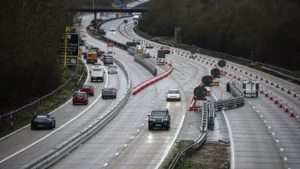Highways England is to test the contingency plans it’s drawn up to cope with any cross-channel disruption in Kent after the UK leaves the EU at the end of the month.
From Friday 11 December, along with the Kent Resilience Forum, Highways England will carry out a live test to mobilise a moveable barrier system on a section of the M20. It’ll mean that parts of the motorway are closed between Maidstone and Ashford for four nights, with signed diversions in place.
The barrier will be used to create a new layout with a contraflow system. Once deployed, this will allow traffic to continue travelling in both directions on the motorway at the same time as port bound HGVs are queued, if necessary, on the coastbound carriageway until they can travel through to the Port of Dover or Eurotunnel.
The barrier is part of Operation Brock, a series of measures aimed at keeping the M20 open in both directions during periods of cross-Channel disruption. During the test the barrier will be installed and then removed.
Highways England says the barrier is much quicker to deploy than previous systems which took weeks to install and remove, and allows more traffic to continue using the motorway, off local roads. It says it plays a key part in managing any disruption at the ports after the EU exit date, 31 December 2020.
HE south east operations director Nicola Bell said, “We have again worked extensively with our partners in Kent and are confident that this test will provide a valuable dress rehearsal into the operation of our Kent-wide port disruption contingency measures. The test will help us to fine tune Operation Brock, finding ways to make the deployment quicker whenever the barrier is needed, whether it be in preparation for transition, or other disruption to cross-channel services.
“Operation Brock will keep Kent moving, and we thank road users in advance for their patience while the test is taking place.”
Transport Secretary Grant Shapps added, “Kent is a critical link to one of our busiest trade routes, and this state-of-the-art technology will ensure that we can keep the local road network moving.
“Testing this barrier now will ensure that if the system is needed it can be quickly and safely deployed, helping drivers get to where they need to be – even in the event of disruption at the end of the transition period and to assist with any other future disruption caused for any reason.”
(Picture – Highways England, Gov.uk)



















